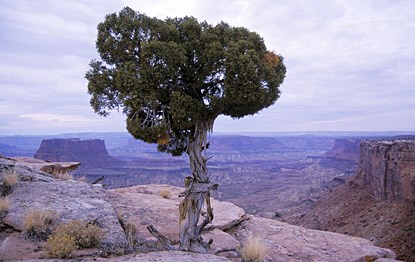
NPS/Neal Herbert Among the majestic spires, canyons, buttes and mesas of Canyonlands can be found a truly amazing tree: the Utah juniper (Juniperus osteosperma). Junipers grow in some of the most inhospitable landscapes imaginable, thriving in an environment of baking heat, bone-chilling cold, intense sunlight, little water and fierce winds. Often they appear to grow straight out of solid rock. On the Colorado Plateau, the juniper, along with the pinyon pine, forms the most prevalent plant community—the pinyon-juniper woodland—between 4,500 and 7,000 feet above sea level. The juniper can withstand drought conditions that often kill other plants and trees. Its hidden secret: a massive underground root system which can account for two-thirds of a tree’s total mass. A juniper’s tap root can penetrate 25 feet straight down in search of water. It can also send out lateral roots 100 feet or more from the tree. The roots are especially hardy: even when knocked over by wind, junipers often continue to grow. 
NPS Photo Junipers grow very slowly. A juniper standing only five feet tall may be 50 years old. Junipers typically live from 350 to 700 years, with some even passing the millennium mark. Despite their longevity, junipers rarely exceed 30 feet in height or three feet in diameter. No two junipers ever seem to look alike: some are bushy, some have multiple trunks, and many have poorly-formed crowns that are a mixture of live and dead branches. To conserve water junipers can self-prune, stopping the nutrient supply to one branch in order to ensure the survival of the tree. Junipers can be identified by their bark, leaves and fruit. The bark is gray or light brown and often hangs in loose, fibrous strips. The leaves are dark green, flat and scaly and do not drop in the fall. The fruit is a pea-sized light blue berry which is actually a tiny pinecone covered with a drought-resistant waxy coating. Animals find the juniper very inviting. The berries are edible, though they are not as popular as pinyon pine nuts. However, juniper berries are a staple for jackrabbits, coyotes, and a variety of birds. This is important for the tree as well since it helps to disperse its seeds. Humans have found many uses for juniper. Americian Indian tribes take advantage of the juniper's medicinal qualities, which include the treatment of stomach aches, coughs, and headaches. The dried seeds can be used for beading necklaces and bracelets and as the "rattle" in rattles. Juniper logs are used to build ceremonial hogans and other structures. Pioneers and cowboys found the rot-resistant wood great for fence posts and shingles, and it has long been favored for firewood. The soft bark has been used as bedding, toilet paper and, when tightly twisted, as a slow-burning match. Junipers have other important functions as well. Their thick green foliage provides shade in an otherwise shadeless landscape. Their oddly twisted trunks, with branches pointing in all directions, have a mystical quality. Each tree is like a fine work of art that one might find in a museum. While these trees are protected at Canyonlands, in many other locations they are cut down for agriculture, grazing and urban development. What would a park like Canyonlands be without juniper trees? It would still be beautiful, but perhaps less enchanting. The juniper adds charm, color and splendor, to the landscape. It provides a stark contrast to the lifeless rock, seemingly happy living in a place where few plants can. It is a master of survival in a harsh environment where ultimately rock perpetuates over time. |
Last updated: April 18, 2025
